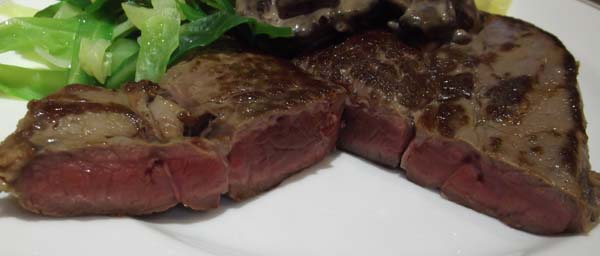 HOME
FARM SHOP
BUTCHERY
DELI
ABOUT US
NEWS
COOKING
HOME
FARM SHOP
BUTCHERY
DELI
ABOUT US
NEWS
COOKING

Venison Cooking Instructions
These are not instructions for cooking all venison, but for cooking our venison: roe deer. They will work for wild roe and muntjac, and steaks and loin from fallow. If you want to know why my cooking methods differ from so many of the traditional instructions, read more at the end.

Steak
Hot pan - 90 seconds - flip - 90 seconds - 5 mins rest
Warm plates, including a plate on which to rest the steaks. Ideally they will rest in a warm (50°C) oven. If you want to make a pan sauce (we normally do) use a frying pan, or you can cook them on a ridged griddle. You need to get either really hot: if using a non-stick pan this will not improve its longevity; stainless or iron are better. Brush oil one side of the steaks and put on the very hot pan / griddle oiled side down for one and a half minutes. Oil the other side before flipping them, cooking the steaks another 90 seconds. If you want your venison more done than in the picture, you can turn the heat down and leave it another minute or so. It will be getting less tender. Rest for 5 minutes while you make your sauce or pour a congratulatory glass of wine. Eat.
Small Roast
Very hot oven - Oil - 20 to 40 mins - meat thermometer 45°C - 15 mins rest
Preheat the oven to 210°C (200° fan), gas mark 7. Brush the joint with olive oil and put in the oven. A small boneless loin will take about 20 minutes. The biggest joint we regularly sell, about two thirds of a boneless haunch, needs more like 40 minutes. With quite small joints, all different shapes, varying ovens and the desire to cook it quite rare, cooking by time alone is a bit hit and miss. Get a meat thermometer! The last one I bought will bleep at me out in the garden via a separate thingy when the right temperature is reached.
The right temperature is 45°C. This is when you take it out of the oven: the internal temperature will carry on going up while it is resting. 15 minutes under foil in a warm place will do.
Do not try and make a traditional gravy: there will be no fat in the pan, and precious little juices. You could make something more like a pan sauce for steak, or use this as an excuse for something luxurious like bearnaise sauce.
Large Roast
Tricky...by the time it is cooked through, parts will be going dry and tough. Fat helps: cutting slits and "barding" with slivers of bacon or pork fat makes a difference. However, it is fiddly and time consuming. Consider other options: a number of small joints, or a pot roast with added fat in the form of bacon, belly pork or just a good slug of olive oil.
Venison in Traditional Recipe Books
There is a tendency for techniques to live on from one cook book to the next. The result is that many books are recommending cooking methods for venison dating from the 19th century. They would almost certainly have been cooking red deer, a big animal weighing six times as much as a roe. Red deer venison needs hanging to tenderise it (like beef), which made it very "gamey" and strong. Marinading, so often recommended, was as much to cut through the gamey taste as to tenderise the meat. Joints are much larger than with roe, so have to be cooked for longer. Hence the need for laborious larding and barding to try and get some fat into it.